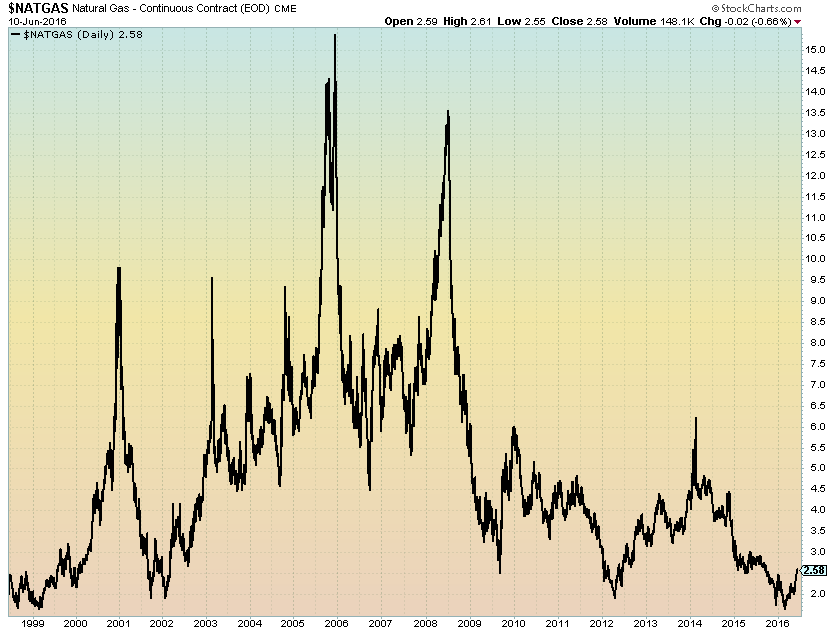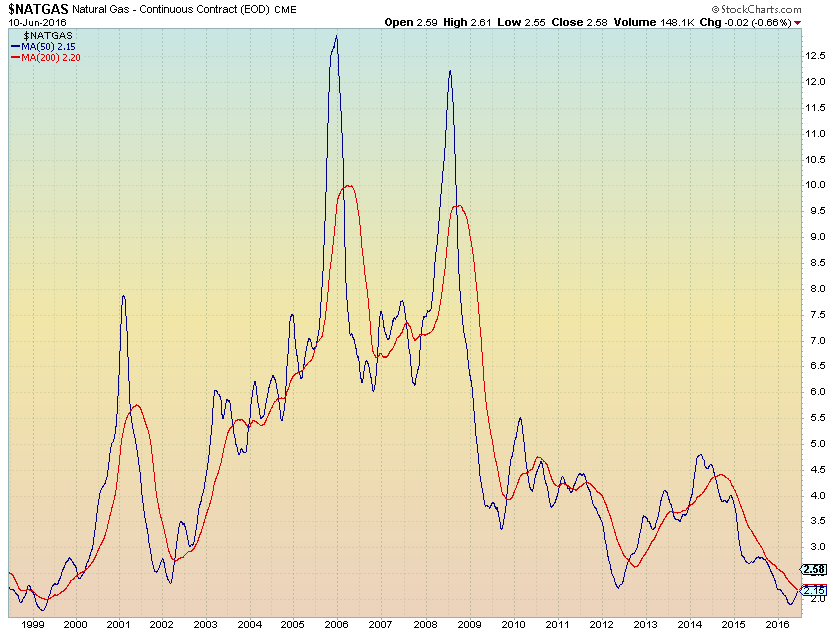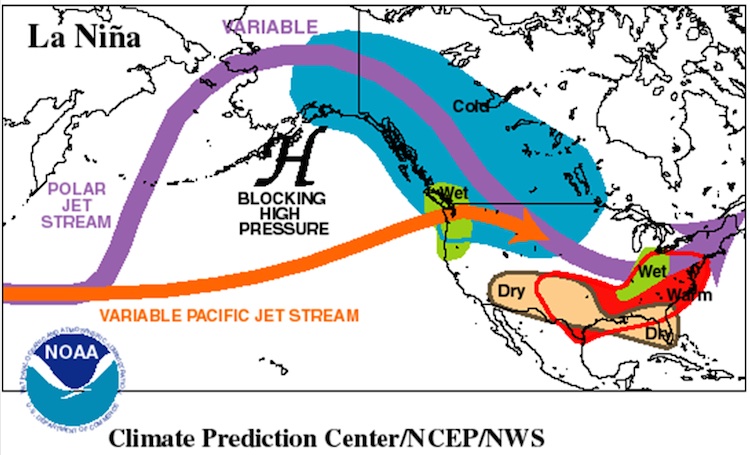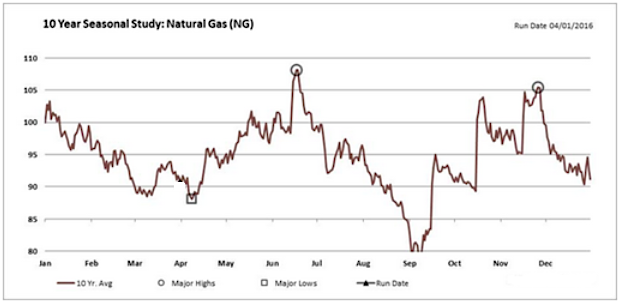Natural Gas traders are eyeing an event not seen since December 2013 – a natural gas golden cross. A golden cross is when the shorter-term 50-day moving average crosses above the longer-term 200-day moving average.
The Energy Information Agency (EIA) provides daily Natural Gas pricing data going back to 1997. Using this data, we can examine if a natural gas golden cross is something energy traders should care about, or if it is just noise. Let’s first take a look at the long-term chart of Natural Gas prices for some perspective.
You will notice a rally from the late 1990s through the mid-2000s. Several Gulf of Mexico hurricanes and subsequent supply shortages in 2005 caused NG to put in all-time highs above $15/MMBtu. Natural Gas prices then declined as supply concerns waned, however the structural bull market in commodities persisted as the US Dollar declined into mid-2008 when NG spiked to near $14. The commodity collapse of 2008 brought the energy commodity to multi-year lows below $3. Some brief wintertime spikes since 2009 have been the only rallies. NG recently put in 20-year lows near $1.60, however a 60% gain since March has brought it back above its 50 and 200-day moving averages.
Natural Gas Prices – Long-Term Chart
According to EIA historical prices, there have been 13 natural gas golden crosses since 1999. The 14th is still pending, but appears imminent to occur later this month or early July. The upcoming moving average crossover will have occurred following the longest period with the 50-dma being below the 200-dma – nearly 500 trading days!
The below chart is helpful to review what the trends are on a chart without seeing price. The “invisible price” chart also shows moving average crossovers. The pricing data does not match exactly with EIA data due to a difference in prompt-month roll dates, but it gives a good representation of the trends. Notice the upcoming golden cross in the bottom right and the prior death cross in the summer of 2014.
Turning to the return data, I want to only look at the returns from natural gas golden crosses that occurred after prolonged death cross periods. Unfortunately, we only have 4 instances of death cross durations of 190 trading days or more. Using these 4 instances, the average maximum gain following the next golden cross is 99.7%! The median maximum gain is 77%. It is impossible to sell the exact high, but it gives you an idea that there has been a trend of continued gains following a Natural Gas golden cross after an extended period with the 50-dma below the 200-dma. The average gain from a natural gas golden cross to subsequent death cross in these 4 occurrences is 10.1% with a median return of 9.2%.
It appears that the Natural Gas rally may have legs following the pending golden cross. For the fundamental folks out there, let’s take a quick look at what might drive NG prices. As has been widely publicized, the El Nino weather pattern is transitioning to La Nina. El Nino is associated with a warming of the equatorial Pacific Ocean waters, while La Nina is a cooling of these waters. El Nino and La Nina are known to have vast climate impacts.
For Natural Gas traders, a La Nina typically leads to hotter summers and colder winters in the highly populated areas of the country. There are other factors at play that determine seasonal temperature patterns, but I will leave that (at least) to the meteorologists. The below map from the National Oceanic and Atmospheric Administration’s (NOAA) Climate Prediction Center (CPC) is the typical temperature pattern during a La Nina summer. Power traders will tell you that the key to energy demand is the I-95 corridor – if we see a hotter than average summer along I-95, then there will be increased demand for “AC Load” or air conditioning usage. La Nina tends to have a warmer than average summer in the southeast into the northeast (bullish power demand).
The winter pattern often yields colder than average temperatures across the northern tier, which may spark high “heating load” during that time.
The technical and weather outlooks for Natural Gas prices appear to be improving. The bearish case would be given by the fundamental guys who analyze storage figures, but I’ll leave that for another day! Another bearish factor is seasonality. As highlighted in my April post, NG tends to rally until the summer solstice, which it has certainly done this year. The below chart from Signal Trading Group shows that seasonality does not favor NG during the summer months.
Thanks for reading.
Twitter: @MikeZaccardi
The author does not have a position in mentioned securities at the time of publication. Any opinions expressed herein are solely those of the author, and do not in any way represent the views or opinions of any other person or entity.











